Victor Westerholm
Victor Westerholm | |
|---|---|
 Westerholm in 1914–1917 | |
| Born | Victor Axel Westerholm 4 January 1860 |
| Died | 19 November 1919 (aged 59) Turku, Finland |
| Nationality | Finnish |
| Known for | Painting |
Victor Axel Westerholm (4 January 1860 Turku – 19 November 1919 Turku) was a Finnish landscape painter, especially known for founding the Önningeby artists' colony.[1]
Biography[]
Victor Axel Westerholm was born in Turku in 1860. He was the son of Viktor Westerholm, a ship's master, and Maria Westerholm (née Andersson). As a child he spent a lot of time at the island of Nagu in the Finnish Archipelago. From 1869 to 1878 he studied at the Finnish Art Society's Drawing School in Turku, under Robert Wilhelm Ekman (1808–1873) and Thorsten Waenerberg (1846–1917); and as a young man he studied under Eugen Dücker (1841–1916) in Düsseldorf from 1878-1880. Much later he studied under Jules Joseph Lefebvre(1836–1911) at the Académie Julian in Paris from 1888-1890.[2][3]
In 1888 he became a teacher at the school of the Society of Art in Turku, and in 1891 became the director of the Turku art museum.[2]

He often painted winter landscapes and sunsets at his summer home, "Tomtebo", at the village of Önningeby in the Municipality of Jomala on the Åland Islands in the Baltic Sea. In 1886, he invited several artists to Tomtebo thus beginning the Önningeby artists' colony (Önningebykolonin). Visiting artists who spent time in Önningeby include J.A.G. Acke, Hanna Rönnberg, Elin Danielson-Gambogi, Edvard Westman and Elias Muukka. Since 1992 Önningeby-museet in Önningeby has exhibited a permanent exhibition of works by the Önningeby artists’ colony.[2][4][5]
Westerholm was an instructor at Turku drawing school in 1887–1898 and 1904–1917. In 1891, he was elected as the curator of the newly formed Art Association in Turku.
Personal life[]



In 1885, he married Hilma Alander. They had one daughter, . Westerholm lived in Turku where he died in November 1919 from a flu that turned into pneumonia.[3]
Works[]

Werner Holmberg's Graveside, 1882

In the Studio, 1883
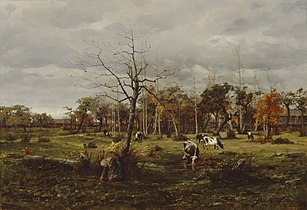
Autumn Landscape, 1883

An October Day in Åland, 1885
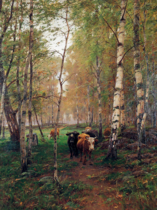
Cows in a Birch Forest, 1886
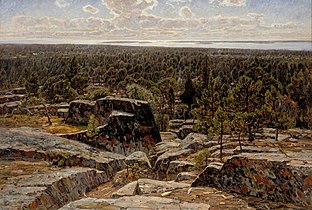
Landscape from Åland, 1895

Seal Hunting, 1900
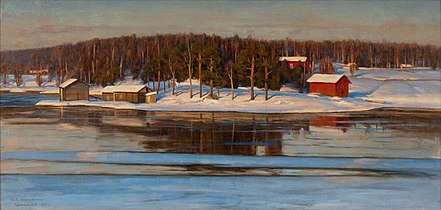
Evening Sun, 1901
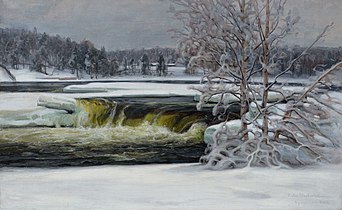
Kymi River, 1902
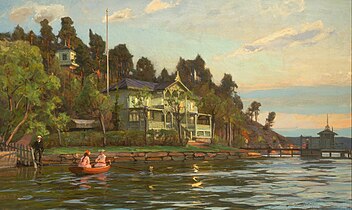
Scene from Hirvensalo, 1903
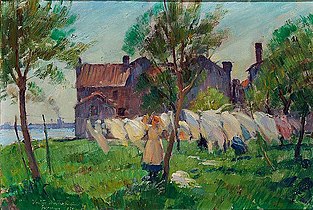
Drying Laundry in the Sun, 1900s

Vallinkoski Rapids, 1917 (fi)
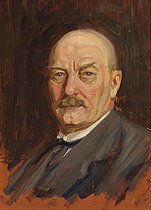
Self-Portrait, 1919
See also[]
Notes[]
- ^ The painting won a bronze medal at the Exposition Universelle of 1889.[6]
References[]
- ^ "Victor Westerholm". Biografiskt lexikon för Finland. Retrieved January 1, 2019.
- ^ Jump up to: a b c The International Studio, v. 33 No. 130 – December, 1907. edited by Charles Holme, Guy Eglinton, Peyton Boswell, William Bernard McCormick, Henry James Whigham. Victor Westerholm, Finnish Landscape Painter. Google Books
- ^ Jump up to: a b Reitala, Aimo (23 September 2015). "Westerholm, Victor (1860 - 1919)". Kansallisbiografia. Retrieved 9 July 2020.
- ^ "The Önningeby artists' colony". konstmuseum. Retrieved January 1, 2019.
- ^ "visitaland.com – The Önningeby colony". Archived from the original on 2011-07-16. Retrieved 2010-11-04.
- ^ Kuvaja, Sini (18 February 2017). "Tunnetko tämän taiteen kultakauden mestarin Noormarkusta? Aikansa kapinallinen eli ja maalasi rohkeasti". Satakunnan Kansa. Retrieved 16 May 2020.
- ^ Valjakka, Timo (30 May 2020). "Hienovaraisesti poliittinen maalaus katsoo länteen Venäjän keisarikunnan läntisimmällä kohdalla Ahvenanmaalla". Helsingin Sanomat. Retrieved 4 August 2020.
External links[]
![]() Media related to Victor Westerholm at Wikimedia Commons
Media related to Victor Westerholm at Wikimedia Commons
- 1919 deaths
- 1860 births
- 19th-century Finnish painters
- 19th-century male artists
- 20th-century Finnish painters
- 20th-century male artists
- Finnish male painters













